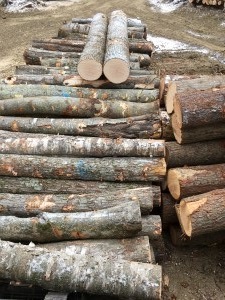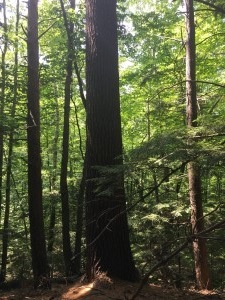Current New Hampshire Timber Prices & Vermont Timber Prices Winter 2020
The fall of 2019 was short. Winter came on fast. By early November we had subzero temperatures and snow on the ground. However, as fast as it came , it quickly disappeared. By early December the snow storms had changed to cold rain and all of the frost in the ground, and snow on top had disappeared. As we enter the new year , this trend seems set to continue. To say it’s a challenge would be an understatement. At the time of this writing, there are very few woodlots in south/central Vermont and New Hampshire that are operable. The ground is too wet and temperatures too high to enable any consistent freezing of the ground. Many of our winter harvests, and those of our colleagues, have been put on hold. We have to wait until the subzero temperatures come back. The silver lining to this warm trend has been the fact that the tough conditions have resulted in a reduced output of harvested wood – leading to low inventories at mills region wide. This is helping to keep to delivered prices up.
Below is a summary of the various regional wood products, broken down by species category
Hardwood Logs :
Prices vary according to species and markets.
 Oak: Because of Chinese tariffs - prices remain very depressed. With very little domestic demand for oak lumber – China drives the market. Any purchasers who are sawing their purchased oak logs into lumber for export has been particularly hard hit by these tariffs. The purchase price they are willing to pay for oak logs reflects this. They are very low. If the sawmill/ log purchaser is just purchasing the raw logs and reselling them – unprocessed- to China the prices are a little better. Trying to sell your standing oak timber, on your own, in this market is risky business . The assistance of a consulting forestry firm like Stillwater Forestry LLC is vital for receiving the best price possible for your timber. Prices are all over the map and you need a trusted ally who will insure your logs are going to the market with the best scale, grade and price.
Oak: Because of Chinese tariffs - prices remain very depressed. With very little domestic demand for oak lumber – China drives the market. Any purchasers who are sawing their purchased oak logs into lumber for export has been particularly hard hit by these tariffs. The purchase price they are willing to pay for oak logs reflects this. They are very low. If the sawmill/ log purchaser is just purchasing the raw logs and reselling them – unprocessed- to China the prices are a little better. Trying to sell your standing oak timber, on your own, in this market is risky business . The assistance of a consulting forestry firm like Stillwater Forestry LLC is vital for receiving the best price possible for your timber. Prices are all over the map and you need a trusted ally who will insure your logs are going to the market with the best scale, grade and price.
Red Maple: Demand is strong and delivered prices remain higher than they were a year ago. The lumber markets for this species are driven by domestic demand.
Sugar Maple: Prices are steady. No lower than they were last year. There is no problem selling sugar maple logs. The mills seem more interested in it because the domestic demand for its lumber remains steady.
Yellow Birch: We have seen the mill delivered prices for this species remain fairly steady as well.
Ash: Prices are strictly driven by what the purchaser is doing with the logs. Like Oak a large part of the demand for ash logs was being driven by China. With the tariffs, that demand has taken a big hit. If your logs are going to an exporter expect lower prices. At Stillwater Forestry LLC we have a couple of value added markets that we sell our client’ ash logs to. One manufactures tool handles and the other squares/dowels. We have found that these markets are paying more than other markets that just export the logs or lumber.
Mat/Tie Logs: Steady demand and strong pricing. This market allows us to turn lower grade logs ,that would have formerly gone into pulp, into a higher value product.
Softwood Logs:
 Spruce: A year ago, prices tanked for spruce fir logs. They dropped by 25% in less than six months. Since then they have flattened out and remained steady. However, demand continues to be strong which helps to give us stability when it comes to selling our client’s harvested spruce/fir.
Spruce: A year ago, prices tanked for spruce fir logs. They dropped by 25% in less than six months. Since then they have flattened out and remained steady. However, demand continues to be strong which helps to give us stability when it comes to selling our client’s harvested spruce/fir.
White Pine: Demand is up along with prices. Recent wet weather has taken its toll on logging production and the pine mills inventories are reflecting this. Very few have sufficient inventories of logs and in some instances the mills lack any inventory at all. With winter halfway over the mills are getting worried they will not have enough logs to see them through the spring mud season. We have seen an increase in prices and a loosening of specs. One of our main markets just dropped their minimum log size down to 5” DBH on the tip. This is great for utilization as it allows us move some logs from pulp into grade logs. This means more money for our clients.
Hemlock: Prices are steady – as they always are with this species. Not really up nor really down. Demand continues to be strong, with the few domestic hemlock mills and the larger mills in Canada all looking to purchase it.
Hardwood Pulp: Markets are wide open with no delivery quotas in sight. Price remain steady.
Softwood Pulp: Demand remains strong and the prices remain steady. With the recent closure of a large pulp mill in Nova Scotia this could all change. As many of the sawmills and loggers who relied on that market may try and ship their residual chips and pulpwood to the large softwood pulp mill in Woodland.,ME. This in turn will have a cascading effect on the markets we rely on in Jay and Rumford. It has the potential to plug the softwood pulp market in Maine very quickly. It’s too early to tell, but it bears watching.
Biomas Chips: The biomass chip market continues to barely exist. A year ago , things looked hopeful but over the course of the summer court battles and political wrangling within the NH legislature took their toll. By the end of the summer NH was left with only three biomass plants still in operation. Vermont has two. Where there used to be nine plants spread throughout both states we now only have five. In the case of NH they’re located far north and south and in Vermont far east and west. Prices are way down and quotas are very tight. Sadly, it appears that the end of the era of biomass electricity in New England is - upon us. It’s a shame really because we are surrounded by prodigious forests filled with low grade wood. Instead of embracing alternative sources of energy that are conducive to the region – like biomass – our political leaders are instead embracing alternatives sources of energy like solar and wind. It’s sheer foolishness as we have over 5 months of the year where half the days are cloudy and although we do have wind, its not consistent like it is in the Midwest. But we do have lots of forests and a willing and able to workforce to manage them, but there is no interest on the part of leaders to embrace this.











